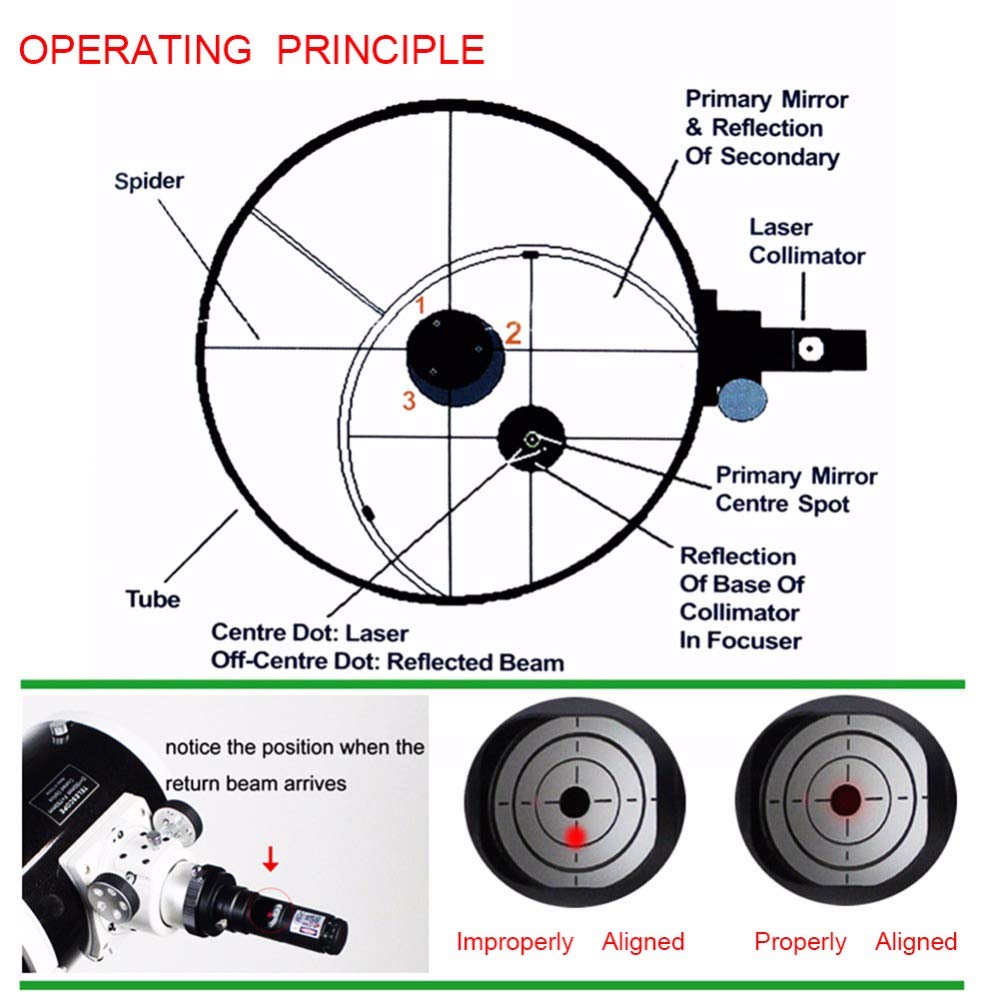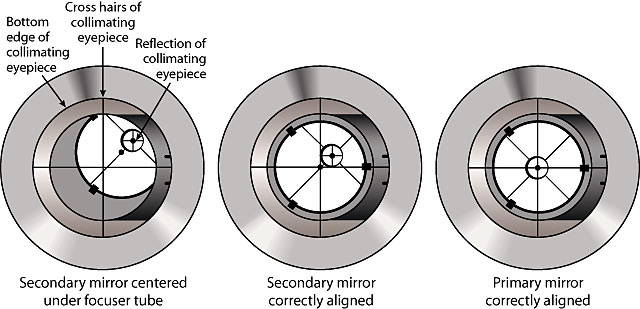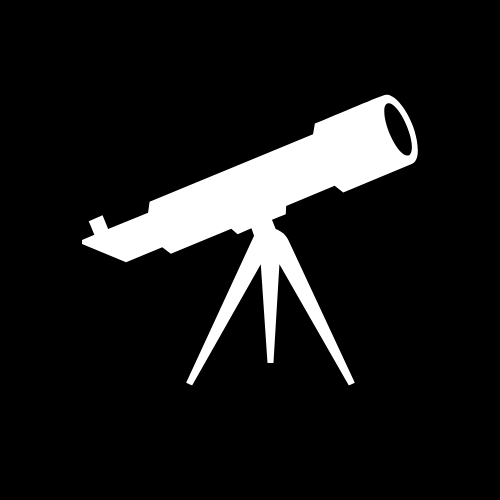Collimating Your Telescope
Welcome to the fascinating world of telescope collimation! If you’re an amateur astronomer or even a seasoned stargazer, you’ve likely heard the term “collimation” thrown around. But what exactly does it mean, and why is it so crucial for your telescope’s performance? In this article, we’ll delve into the art and science of collimating your telescope, a process that ensures your telescope’s optics are perfectly aligned for the best possible views of celestial objects.
The Importance of Collimation
Imagine spending a considerable amount on a high-quality telescope only to find that the images it produces are blurry or distorted. Frustrating, isn’t it? That’s where collimation comes in. Proper collimation ensures that your telescope’s optics are aligned in such a way that they produce sharp, clear images. Whether you’re looking at the Moon’s craters or distant galaxies, collimation can make a world of difference in your observational experience.
Common Misconceptions
Many people shy away from collimating their telescopes, thinking it’s a complex or technical process best left to the experts. While it’s true that collimation requires a certain level of precision, it’s not an insurmountable task. With the right tools and guidance, even beginners can successfully collimate their telescopes. Another misconception is that once you collimate your telescope, it stays that way forever. In reality, telescopes can lose their collimation due to various factors like transportation or even temperature changes, making regular checks necessary.
So, if you’re ready to get the most out of your telescope, read on as we demystify the process of collimation and guide you through its intricacies.

What is Collimation?
Collimation, in the context of telescopes, refers to the precise alignment of the optical elements within the telescope’s optical tube. This alignment ensures that light entering the telescope is accurately focused at the eyepiece, providing you with the clearest and sharpest images possible. In simpler terms, collimation is the process of making sure that all the mirrors or lenses in your telescope are pointing in the right direction so that they work together harmoniously.
Importance in Telescope Performance
The performance of a telescope is critically dependent on its collimation. A well-collimated telescope will produce images that are sharp, clear, and full of detail. On the other hand, a poorly collimated telescope can result in images that are blurry, distorted, or even completely out of focus. This is particularly true for telescopes with higher magnifications, where even slight misalignments can significantly degrade image quality.
Collimation is not just about getting pretty pictures; it’s also about maximizing the scientific capabilities of your telescope. For those interested in astrophotography or detailed observations, accurate collimation is essential for capturing the fine details of celestial objects. Even for casual stargazers, proper collimation can mean the difference between a frustrating night and a rewarding, awe-inspiring experience.
In summary, collimation is a crucial aspect of telescope maintenance that directly impacts your viewing experience. Whether you’re a beginner or an experienced astronomer, understanding and applying the principles of collimation will significantly enhance your stargazing adventures.
Basic steps involved in collimating a telescope
| Step | Description | Tools Needed | Tips |
|---|---|---|---|
| Understanding Collimation | Learning what collimation means and why it’s necessary. | N/A | Research or consult manual for specifics. |
| Initial Inspection | Checking if the telescope is out of collimation. | Collimation cap or laser collimator | Look for misalignment in the reflection. |
| Adjusting the Primary Mirror | Fine-tuning the primary mirror alignment. | Allen wrench or screwdriver | Make small adjustments and recheck. |
| Adjusting the Secondary Mirror | Aligning the secondary mirror. | Allen wrench or Phillips head screwdriver | Ensure it’s centered in the eyepiece view. |
| Final Testing | Testing the collimation on a star. | Telescope, clear night sky | Use a bright star and defocus slightly to check. |
| Regular Checks | Maintaining proper collimation. | Collimation tools | Regularly check, especially after moving the telescope. |
Types of Telescopes and Collimation

Newtonian Telescopes
Newtonian telescopes, also known as Newtonian reflectors, are one of the most common types that require regular collimation. These telescopes use a primary parabolic mirror and a flat secondary mirror to focus light. Collimation in a Newtonian involves aligning these two mirrors so that they perfectly focus light onto the eyepiece.
Dobsonian Telescopes
Dobsonian telescopes are essentially Newtonian telescopes mounted on a different type of base. They too require regular collimation for optimal performance. The process is similar to that of a standard Newtonian telescope, involving the alignment of the primary and secondary mirrors.
Schmidt-Cassegrain Telescopes
Schmidt-Cassegrain telescopes (SCTs) are a bit more complex in design, combining lenses and mirrors. Collimation for SCTs usually involves adjusting the secondary mirror. While these telescopes hold their collimation well, they still require occasional checks and adjustments, especially if they are transported frequently.
Refractor Telescopes
Refractor telescopes, which use lenses rather than mirrors, generally require less frequent collimation. When they do need adjustments, the process is often more complex and may require professional servicing.
Collimation Techniques for Different Types
Each type of telescope has its own specific collimation techniques, tools, and procedures. For example, Newtonians often use a simple collimation cap or a laser collimator, while Schmidt-Cassegrains may require more specialized equipment like a star diagonal and artificial star for accurate collimation.
Understanding the type of telescope you have is the first step in the collimation process. Each type has its own set of challenges and methods for achieving optimal alignment. Regardless of the type, regular collimation checks are essential for maintaining the best possible performance from your telescope.
Tools Needed for Collimation
Laser Collimators
Laser collimators are specialized devices that emit a laser beam to help align the optical elements of your telescope. They are particularly useful for Newtonian and Dobsonian telescopes. The laser beam provides a precise point of reference, making it easier to align the primary and secondary mirrors.
Hex Keys
Hex keys, also known as Allen wrenches, are often needed to adjust the screws that hold the mirrors in place. These tools come in various sizes, so it’s essential to know which size fits the screws on your specific telescope model.
Screwdrivers
Flat-head and Phillips screwdrivers are commonly used for making adjustments to the telescope’s optical elements. Some telescopes come with specialized screws that require specific types of screwdrivers, so always check your telescope’s manual for guidance.
Collimation Caps
A collimation cap is a simple tool that fits into the focuser and helps you align the telescope by eye. It’s generally less precise than a laser collimator but can be effective for quick checks and minor adjustments.
Cheshire Eyepiece
A Cheshire eyepiece is another manual collimation tool that helps align the primary and secondary mirrors. It’s often used for fine-tuning after a laser collimator has been used.
Where to Purchase Tools
These tools can be purchased from specialized astronomy shops, online retailers, and sometimes even at general hardware stores. Some telescope kits come with basic collimation tools, but for more advanced or precise work, specialized tools may be necessary.
Having the right tools for collimation is crucial for the process to be effective and efficient. Whether you’re using a laser collimator for precision or hex keys for manual adjustments, make sure you have all the necessary tools on hand before you begin the collimation process.
The Collimation Process: A Step-by-Step Guide

Preparation
- What to Do: Make sure your telescope is on a stable surface and that you have all the necessary tools at hand.
- Tips: It’s best to collimate in the same position that you’ll be observing, as changing the telescope’s orientation can sometimes shift the mirrors.
Rough Alignment
- What to Do: Insert the collimation cap or Cheshire eyepiece into the focuser and look through it. You should see the secondary mirror and the reflection of the primary mirror.
- Tips: If the mirrors look significantly misaligned, you may need to do a rough alignment by manually adjusting the secondary mirror first.
Aligning the Secondary Mirror
- What to Do: Use the hex keys or screwdrivers to adjust the tilt of the secondary mirror until the reflection of the primary mirror is centered.
- Tips: Make small adjustments and frequently check through the collimation cap to see the changes.
Aligning the Primary Mirror
- What to Do: Remove the collimation cap and insert the laser collimator. Turn it on and adjust the primary mirror screws until the laser hits the target on the collimator.
- Tips: Again, make small adjustments and double-check your work. Some telescopes have locking screws that should be tightened after the collimation screws are set.
Fine-Tuning
- What to Do: Replace the laser collimator with the Cheshire eyepiece or collimation cap for a final check. Make any necessary fine adjustments.
- Tips: If you’re struggling to get perfect alignment, remember that “good enough” often really is good enough for most visual observing.
Test Your Work
- What to Do: Remove all collimation tools and insert an eyepiece. Point the telescope at a bright star and defocus the image slightly. The resulting light circle should be symmetrical.
- Tips: If the circle is not symmetrical, you may need to go back and make minor adjustments to the primary or secondary mirror.
Collimating a reflector telescope may seem daunting at first, but with the right tools and a systematic approach, it becomes a straightforward task. Proper collimation significantly improves the quality of your observations, making the effort well worth it.
Common Collimation Issues and How to Solve Them
Laser Collimator Not Seated Properly
- Problem: The laser collimator isn’t fitting snugly in the focuser, leading to inaccurate readings.
- Solution: Ensure the collimator is clean and free of debris. Tighten the focuser’s locking screw to secure the collimator in place.
Secondary Mirror Appears Oval or Distorted
- Problem: When looking through the collimation cap, the secondary mirror appears oval rather than circular.
- Solution: This could be due to the tilt of the secondary mirror. Adjust the secondary mirror screws to correct the tilt until the mirror appears circular.
Laser Dot Misses the Target
- Problem: The laser dot is not hitting the target on the collimator or is way off-center on the primary mirror.
- Solution: This usually indicates that the secondary mirror is significantly misaligned. Start by adjusting the secondary mirror first, then proceed to the primary mirror.
Collimation Seems Perfect, but Views Are Still Poor
- Problem: Despite seemingly perfect collimation, the views through the telescope are not sharp.
- Solution: Check for other issues like dirty optics, poor seeing conditions, or thermal instability within the telescope tube. Allow the telescope to acclimate to the outdoor temperature.
Difficulty in Adjusting Screws
- Problem: The collimation screws are too tight or too loose, making adjustments difficult.
- Solution: If screws are too tight, gently use a tool for added leverage. If they are too loose, consider replacing them or adding a washer for better grip.
Collimation Holds for Only a Short Time
- Problem: The telescope loses its collimation quickly after adjustments.
- Solution: This could be due to mechanical issues like loose screws or an unstable mount. Make sure all screws are tightened and the mount is stable.
Advanced Collimation Techniques
Star Testing
- Description: Using a bright star to fine-tune collimation by observing the concentric rings around it.
- How-to: Center a bright star in the eyepiece and defocus it slightly. The resulting diffraction rings should be concentric. If not, minor adjustments are needed.
Cheshire Eyepiece
- Description: A specialized collimation tool that provides more accuracy than a simple collimation cap.
- How-to: Insert the Cheshire eyepiece into the focuser and adjust the mirrors until the reflected circles align perfectly.
Autocollimators
- Description: A tool that uses multiple reflections to achieve extremely accurate collimation.
- How-to: Place the autocollimator in the focuser and adjust until you see a single, centered reflection.
Barlowed Laser Method
- Description: Combines a Barlow lens with a laser collimator for high-precision collimation.
- How-to: Insert a Barlow lens before the laser collimator. The expanded laser beam provides a larger target, making it easier to achieve precise alignment.
Software-Assisted Collimation
- Description: Software like Metaguide and CCD Inspector can assist in collimation by analyzing star shapes in real-time.
- How-to: Connect your telescope to the software and follow the on-screen instructions for adjustments.
The Role of Software in Aiding Collimation
- Real-Time Analysis: Software can provide real-time feedback, allowing for immediate adjustments.
- Precision: Software algorithms can detect even minor misalignments that might be missed by the human eye.
- Data Logging: Some software options allow you to log collimation data, helping you understand how your telescope holds collimation over time.
Maintenance and Regular Checks
Importance of Regular Collimation Checks
- Optimal Performance: Regular collimation ensures that your telescope is always performing at its best, providing sharp and clear images.
- Longevity: Proper alignment can extend the life of your telescope by reducing wear and tear on the optical elements.
- Quality Observations: Consistent collimation checks mean consistent quality in your astronomical observations, whether you’re stargazing or capturing astrophotographs.
How Often Should You Collimate Your Telescope?
- After Transport: Always check collimation if the telescope has been moved or transported.
- Seasonal Checks: Temperature changes between seasons can affect telescope mirrors and require re-collimation.
- Type of Use:
- Casual stargazers may only need to collimate every few months.
- Serious astronomers and astrophotographers should consider a quick check before each observing session.
Quick Collimation Checks
- Star Test: A quick star test can often tell you if your telescope is in need of collimation.
- Visual Inspection: Some issues, like a visibly tilted secondary mirror, can be spotted and corrected quickly.
Regular maintenance and collimation checks are crucial for any telescope owner. The frequency of these checks can vary depending on how often and under what conditions the telescope is used. Quick tests can help you decide if a full collimation is necessary.
Summary of the Importance of Collimation
- Optimal Viewing: Proper collimation is essential for achieving the best possible views through your telescope. A well-collimated telescope can mean the difference between a blurry planet and a crisp, detailed view of Jupiter’s bands or Saturn’s rings.
- Enhanced Astrophotography: For those interested in capturing the night sky, collimation is crucial for producing high-quality images. Even a slight misalignment can result in poor focus and reduced image quality.
- Long-Term Care: Regular collimation checks extend the lifespan of your telescope, ensuring that you’ll be able to enjoy stargazing for years to come.
Collimation might seem like a daunting task, especially for beginners, but it’s a fundamental skill that every telescope owner should learn. With practice, the process becomes quicker and easier, and the rewards in terms of improved viewing and imaging are well worth the effort. So don’t shy away from this essential maintenance task—embrace it as part of your journey in exploring the cosmos.
Additional Resources
Tutorials and Videos for Further Reading and Assistance
- Sky & Telescope’s Collimation Guide: A comprehensive guide that covers the basics and advanced techniques.
- Gary Seronik’s Collimation Articles: A series of articles that delve into the nitty-gritty of collimation.
- YouTube Collimation Tutorials: Various experts and amateur astronomers share their collimation tips and tricks on YouTube. Channels like “Fraser’s Stargazers” and “Orion Telescopes” offer valuable insights.
Forums for Community Support
- Cloudy Nights: A popular forum where you can ask questions and share your collimation experiences.
- Reddit’s r/telescopes: A subreddit dedicated to all things telescopes, including collimation.
- Stargazers Lounge: Another forum where you can seek advice and share tips on collimation.
Recommended Brands and Models of Collimation Tools
- Orion LaserMate Deluxe II Collimator: A well-regarded laser collimator that’s easy to use.
- Farpoint Collimation Kit: Includes a Cheshire eyepiece and auto-collimator for precise adjustments.
- Celestron Collimation Eyepiece: An affordable option for beginners.
FAQ Section for “Collimating Your Telescope”
What is Collimation in a Telescope?
Collimation refers to the alignment of the optical elements in your telescope for optimal performance.
Why is Collimation Important?
Proper collimation ensures that the telescope delivers sharp and clear images.
How Often Should I Collimate My Telescope?
It depends on the telescope type and usage, but checking before each observing session is a good practice.
Can I Collimate My Telescope Myself?
Yes, most telescope users can learn to collimate their instruments with some practice.
What Tools Do I Need for Collimation?
Basic tools include a collimation cap, laser collimator, or Cheshire eyepiece.
Is Collimation Necessary for All Types of Telescopes?
Collimation is most critical for reflector telescopes, particularly Newtonian reflectors.
How Do I Know If My Telescope Needs Collimation?
A star test is a common method: a slightly out-of-focus bright star should appear symmetrical.
Does Collimation Affect a Telescope’s Magnification?
No, but it significantly affects the quality of the images produced.
